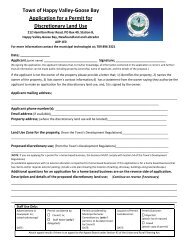Habitat Conservation Plan Habitat Conservation Plan for the Town ...
Habitat Conservation Plan Habitat Conservation Plan for the Town ...
Habitat Conservation Plan Habitat Conservation Plan for the Town ...
- No tags were found...
Create successful ePaper yourself
Turn your PDF publications into a flip-book with our unique Google optimized e-Paper software.
16 <strong>Habitat</strong> <strong>Conservation</strong> <strong>Plan</strong>Figure 2 - Canada Goose Artificial Nesting Island. Photo by EHJV staffGeese are territorial when nest structures are placed closer than ~100 meters, andespecially when structures are within sight of one ano<strong>the</strong>r. Loafing sites should beprovided close to <strong>the</strong> structures. Structures should be placed 10-15 meters from <strong>the</strong>shoreline so that predators cannot harass nesting birds and should be anchored firmlywith enough slack to avoid flooding of <strong>the</strong> structure during periods of high water.Styrofoam or some sort of flotation device like “fenders” should be installed under <strong>the</strong>structure to ensure buoyancy and mitigate flooding potential. Given that goslings cannotnegotiate a vertical rise of more than four inches, each 6 to 8 inch high nest box wouldrequire a ramp six inches wide and oriented at an approximately 45 degree angle.Nesting material placed into <strong>the</strong> nest box should <strong>for</strong>m a bowl with tapered edges so that<strong>the</strong> gosling ramps and nest bowl permit <strong>the</strong> young to exit <strong>the</strong> nest box.Maintenance is done in winter, which means easy access to nest structures via snowshoes or skis. Monitoring would also <strong>for</strong>m an important part of <strong>the</strong> nest raft project toascertain level of occupancy and nest success. This type of project would be a realisticone <strong>for</strong> a <strong>Conservation</strong> Green Team.Ospreys:Ospreys are fish eating raptors that are frequently observed hunting in wetland habitats,particularly those along <strong>the</strong> coast. Un<strong>for</strong>tunately, populations of <strong>the</strong>se birds plummetedin North America during <strong>the</strong> 1950’s and 1960’s due to <strong>the</strong> wide spread use of pesticidesand o<strong>the</strong>r pollutants which have a tendency to bioaccumulate in birds of prey, like <strong>the</strong>osprey. For many osprey populations, bioaccumulation results in frequent reproductivefailures. With <strong>the</strong> banning of many pesticides in <strong>the</strong> early 1970’s, many ospreypopulations have made a comeback.






